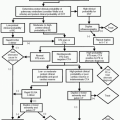Orbital and Periorbital Infection
David J. Grelotti
Nafi Aygun
Anatomy.
The orbits are conical in shape and contain the globes, cranial and autonomic nerves, extraocular muscles, vessels, lacrimal gland and tear ducts, and fat and connective tissue. Seven bones make up the orbit and the periosteum of these bones borders the orbit. An extension of the periosteum, the orbital septum, covers the anterior margin of the orbit and attaches over the front of the tarsal plates. The periosteum and orbital septum together form a relative barrier against the spread of infection into the orbit. An inflammatory process is described as either periorbital or preseptal if it is localized to the skin and subcutaneous areas of the eyelid (i.e., anterior to the septum). An inflammatory process within the orbit is described as either orbital or postseptal (i.e., posterior to the septum).
Pathophysiology.
Despite the barrier formed by the periosteum and septum, infection still reaches the intraorbital space. The most common origin is from the paranasal sinuses, with extension occurring through numerous tiny foramina in the lamina papyracea that separate the orbits from the ethmoid sinuses. Additionally, an extensive venous system surrounds the orbit and consists of valveless veins that can serve as conduits for infection into the orbit from the paranasal sinuses as well as from the soft tissues of the face. In a similar manner, infection can be transmitted from the orbit into the intracranial compartment, which is often catastrophic. Less commonly, orbital and periorbital infections can occur secondary to trauma, foreign bodies, or bacteremia. Detecting extension into the subperiosteal or postseptal space is important in that surgical intervention may be required, whereas preseptal cellulitis typically responds to antibiotics.
Clinical Presentation.
Infections involving the region of the orbit occur most commonly in children. Periorbital cellulitis is more common than orbital cellulitis (90% versus 10%) and is unilateral 90% of the time.
Periorbital cellulitis occurs at any age group without gender preference but is more common in children with a mean age of 21 months. It is caused by infection with Staphylococcus aureus or group A Streptococcus secondary to trauma (e.g., insect bites) or caused by infection with Streptococcus pneumoniae secondary to bacteremia. It is characterized by soft tissue swelling, often involving the eyelid, with associated erythema, warmth, and tenderness. There is no proptosis, chemosis, or decreased ocular motility.
Orbital cellulitis occurs in older children and adults. It can occasionally be the result of infection after penetrating trauma, but it most often occurs in the setting of sinusitis. S. pneumoniae, Haemophilus influenzae, Moraxella catarrhalis, group A Streptococcus, S. aureus, and/or anaerobes are the likely causative agents. In the early stages of orbital cellulitis, the infection is limited by the periosteum and presents as subperiosteal phlegmon or abscess. Later, infection infiltrates the periorbital and retrobulbar fat and causes thrombosis of the ophthalmic vein and cavernous sinus. The clinical presentation is characterized by diffuse inflammatory edema, proptosis, chemosis, decreased ocular motility, decreased visual acuity, swelling and erythema involving the periorbital regions, fever, and/or leukocytosis. With intracranial involvement, neurologic symptoms appear.
Indications.
If orbital cellulitis is suspected, a computed tomography (CT) should be performed.
Protocol.
Intravenous contrast may obscure foreign matter, but it is useful in locating and characterizing the extent of the underlying inflammatory process. To provide the best visualization of an abscess in the inferior and superior orbit, scans should be studied in both axial and coronal planes.




